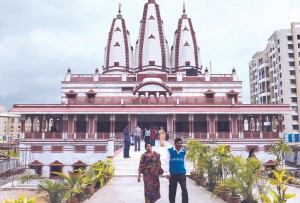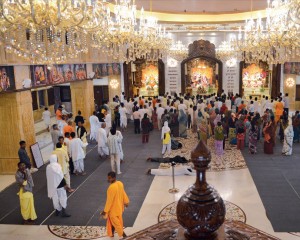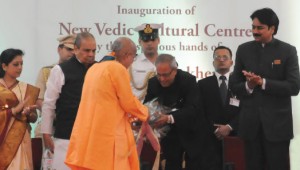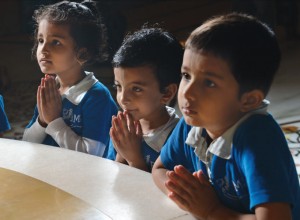The President of India praises Srila Prabhupada at the grand opening of ISKCON Pune’s new temple complex.
Peace and harmony were the recurring themes as the President of India, Pranab Mukherjee, inaugurated ISKCON’s new spiritual and cultural complex in the Indian city of Pune on February 24, 2013. After describing the founder acharya of ISKCON, Srila Prabhupada, as an “exemplary ambassador of Indian culture,” the President called upon the movement to dedicate itself to the cause of humanity by spreading the message of peace, harmony, love, and compassion. Mukherjee further said that India is the place of the oldest civilization in the world and added, “The message of Indian civilization is that of compassion, sacrifice, and renunciation.”
Built over a span of seven years, the eight-million-dollar project, known formally as the New Vedic Cultural Centre (NVCC), is one of the largest temples in Pune, with a built-up area of over 200,000 square feet spread over six acres of landscaped gardens. The cultural complex comprises two temples and four sets of deities. The main temple, built using customary red stone and marble, was constructed in North Indian architectural style and houses deities of Radha-Vrindavanacandra, Jagannatha-Baladeva-Subhadra, and Gaura-Nitai, several murals depicting pastimes of Krishna, and a magnificent temple hall with elaborate domes. The other temple in the complex, built using Kota stone (a fine-grained limestone), is a replica of the Balaji temple in Tirumala and houses the deities of Sri Venkateshvara Balaji and His consorts Sridevi and Bhudevi.
The Centre includes a multipurpose hall for about two thousand people on the ground floor, an annadan (prasada-distribution) hall for three thousand, a residential complex for three hundred brahmacharis, several conference and seminar rooms, a gift shop, and a snack bar. Upcoming features include a fine-dining restaurant offering various vegetarian cuisines and a multi-media theater.
The History

Pune is an ancient city that has existed since 847 CE and was known at that time as Punya nagari, or “the city of virtue.” It is situated 175 kilometers southeast of Mumbai and is the eighth largest metropolis in the country. The city was once the center of power of the medieval Maratha empire. In the twentieth century it grew to become a hub for nationalistic activities for achieving independence from British rule.
Srila Prabhupada visited Pune in 1976 and stayed at the residence of Bahri Malhotra, a prominent businessman and famous philanthropist. While staying in his house, Srila Prabhupada told him, “I want to have a temple in Pune. Can you please help me build one?”
His Holiness Gopala Krishna Goswami, ISKCON’s governing body commissioner for Pune, met Mr. Malhotra every time he visited Pune. In 1982, Mr. Malhotra and his friend Ramesh Thakkar helped ISKCON rent a bungalow from a retired army colonel in a military area in Pune known as Camp. The devotees installed deities of Radha-Kunjabihari and Gaura-Nitai in the rented temple and started spreading Krishna consciousness from there.
Running Out of Space
His Holiness Gopala Krishna Goswami invited His Holiness Radhanatha Swami to join him in developing the Pune temple. Beginning in 1994, Vrindavana Dasa and Krishnananda Dasa served as temple presidents for a few years and developed the congregation in Pune.
In 1995, Radhesyama Dasa, a graduate of the Indian Institute of Technology (IIT), came to the Pune temple to develop the youth congregation. He became the temple president in 1997. Under his leadership many innovative ideas took root. For example, he compiled introductory courses on the Bhagavad-gita for university students and set up youth hostels for devotee students, called Vedic Oasis for Inspiration, Culture and Education (VO ICE).
The congregation started swelling its ranks, and several home programs sprung up all over the city. Also begun were a counseling program to provide personal guidance and care for the needs of the congregation, and several corporate training programs on stress management and life management. Sunday classes took shape for young children, older children, adolescents, and the elderly.
Soon, devotees and visitors started feeling the pinch. Sunday feasts and festivals were jam-packed. Devotees, congregation members, and visitors had to compete for every square inch of space. The 150 resident brahmacaris shared three or four rooms in a mood of great austerity in the service of the Lord. Concerned that space limitations were hindering attempts to spread Krishna consciousness, devotees prayed to the Lord to reveal His plans.
Balaji Makes an Appearance
Dr. Bamandev Bannerjee, an elderly eye-surgeon, was living alone in a big house. He had no children, and his wife had died a few years earlier. He visited the ISKCON temple in Pune and met His Holiness Gopala Krishna Goswami. Dr. Bannerjee was highly impressed by the opulent and strict standard of deity worship in ISKCON, which followed the traditional pancharatriki system, and placed a request before Gopala Krishna Goswami.

“I have a large deity of Lord Venkateshvara Balaji in my house,” he said. “But due to old age, I am not able to take care of the Lord. Can you please send some of your priests to look after my deities regularly?”
Gopala Krishna Goswami immediately instructed the devotees to visit Dr. Banerjee and worship His deities. The deity of Lord Balaji looked splendorous. He had an image of the goddess of fortune, Sri Lakshmidevi, adorning His chest. He wore several necklaces reaching from His shoulders to His feet, had a high crown resting on His head, and sported a large tilaka mark on His forehead that partially hid His eyes exactly as He looks in the holy dhama of Tirupati, where millions of pilgrims flock every day to have His darshana.
Pleased with the efforts of the devotees, Dr. Bannerjee told Gopala Krishna Goswami that he would bequeath his property to ISKCON if the devotees promised to continue to take care of Lord Balaji after his death. Three years later, Dr. Bannerjee passed away, and true to his promise he left his property and Lord Balaji to ISKCON. He had the firm conviction that only the ISKCON devotees would fulfill his deep desire to glorify Lord Balaji after he had gone.
A few weeks later, a small shrine was erected on the side of the main temple in the rented premises. Lord Balaji came to reside there to the delight of the devotees.
Lord Venkateshvara Balaji is called shriya-pati, or the husband of the goddess of fortune. By His mercy, the devotees suddenly had enough funds to consider building a more permanent center in Pune. The $200,000 dollars from the sale of the bungalow became the seed money for turning Srila Prabhupada’s instructions in 1976 into reality.
Krishna Sends the Perfect Team
HH Gopala Krishna Goswami instructed the devotees to use the funds to buy land for a new temple. The devotees found a six-acre plot with a small hill on the Katraj-Kondhwa road in the suburbs of Pune.
“We had no funds and no expertise, and no one on our team,” remembers Radhesyama Dasa. “We did not even know where to begin. Then the Lord sent a team of professional devotees who were experts in various activities such as fund raising, construction, government liaison, event management, media, and publicity. By His divine arrangement we began building the new temple for the satisfaction and pleasure of Srila Prabhupada.”
Srigurucarana Dasa, a young brahmachari, became project director for the construction of the NVCC. Under his vision and leadership, several other devotees became inspired to join the team. He established two teams for fund raising. One, called the Patrons Care department, cultivated elite business persons to raise over $500,000. Another, consisting of six hundred congregation members, approached their network of families and friends for support. Over 40,000 families were engaged in supporting the temple, and they raised more than $400,000.
“Lord Krishna sent us an amazing team of architects, civil engineers, consultants, interior decorators, and many others who offered their services free in the service of the Lord,” recollects Srigurucarana Dasa. “Another challenge was the huge amount of paper work and permissions that were needed from state and local government to construct a building for public worship. Again, Lord Krishna sent a team that was highly familiar with the way the government functions.”
The fund-raising drive was so successful that Gopala Krishna Goswami once remarked to the devotees, “Not a single day did the construction stop because of lack of funds.”
Capturing the Hearts Of Pune Residents

The fund-raising team decided that their campaign would be successful only if the residents of Pune learned about the project through a media and publicity blitz. They put up billboards on all major roads, and inserted advertisements and sponsored eight-page pullout supplements in India’s largest circulation English newspaper, the Times of India.
They held a major event every year that attracted unprecedented media attention. The first year, a “Sudarshan Mahayajna” was organized at the construction site, with a gigantic altar that covered over five hundred square feet.
The next year, the devotees staged a mega-play, called “Sambhavami Yuge Yuge,” based on the Bhagavad-gita. Seen by thirty-five thousand people over seven days, the extraordinary and spectacular show had more than three hundred actors on a stage that was six stories high. It featured gorgeous costumes, enthralling music, captivating dialogues, and live elephants, and received critical acclaim from the media.
The third year, the devotees organized a painting contest with 160,000 children from various schools in Pune that broke the Guinness World Record and received a mention in the book.
“Pune cities were flooded with regular news about the upcoming temple,” says Radhesyama Dasa. “Over a four-year period, we cultivated major businesspersons not only to seek financial support but also to care for their spiritual life. Several supporters became practicing devotees and started regularly chanting the Hare Krishna maha-mantra.”
Amazing Devotees, Amazing Stories
The dedication and determination of the devotees at the Pune temple to fulfill Srila Prabhupada’s instructions to build a temple became the source of many interesting and remarkable stories.

“One of our schemes asking people to sponsor one square foot for $40 was so successful that over seven hundred congregation devotees got sponsorship from more than two thousand people,” says Srigurucarana Dasa. “Even maids in devotee houses who were earning less than $200 a month started sponsoring a square foot. Many children saved their pocket money and sponsored a square foot.”
Krishna Venu Dasa, an elderly devotee who is partially blind, once got into an elevator and started speaking to a man, who promised to donate $200. By the time they reached the tenth floor, Krishna Venu had convinced him to donate $2,000.
A young mother who had just given birth to a baby wanted to contribute her services to the temple. So determined was she that, just a few days after the birth of the baby, she carried the newborn infant on her shoulders and visited three hundred houses over three days to collect $2,000.
While the interiors of the temple were being built, one of the contractors tried to use low-quality materials for the ceilings. As his workers began installing the ceiling, four huge monkeys suddenly arrived at the construction site and pranced around on the ceiling. It broke and came down with a crash, exposing the bad quality of the material being used. The contractor never used substandard material again.
Following the scriptural guidelines for building a temple, the devotees installed beneath the foundation the deity of Ananta-sesa, the celestial thousand-headed serpent on which Lord Vishnu lies down. Immediately after the installation, two large cobras came onto the property and started residing there. The devotees would often see the snakes slithering around the temple site, but they did not harm anyone. Many devotees felt a keen sense of protection whenever they appeared. The snakes disappeared from the land just before the inaugural event and have not been seen since.
The President of India Agrees To Inugurate the Temple
HH Gopala Krishna Goswami invited the President of India to inaugurate the temple, and the President agreed to the request. With two months left before the inauguration, the devotees had to race to finish the construction. There were still many details to be completed, and the land around the temple looked like a massive construction site, with heaps of rubble and leftover construction material lying all around.
The resident devotees then requested congregation devotees to help, and three hundred came every day after work to lift bricks, shift rubble, clear the ground, lay grass, and plant trees.
Finally, on February 6, Lord Balaji was moved in a decorated ratha (chariot), followed by a huge procession from the old temple in Camp to the new temple. The procession started a fifteen-day program of festivities, leading to the grand installation and abhisheka (bathing) ceremony for the deities on February 23. Around 40,000 devotees attended the event from all over the world.
When the President of India formally inaugurated the New Vedic Cultural Centre, he said in his keynote address, “In the years that Swami Prabhupada spent spreading his simple message, he convinced hundreds of thousands of Indians and westerners about the profound value of his philosophy, which they embraced along with a Vedic lifestyle. Throughout his mission, Swami Prabhupada remained faithful to the guidance of Sri Caitanya Mahaprabhu, who had revitalized the bhakti-yoga tradition in the fifteenth century.”
“The NVCC project is meant for all audiences and age groups,” commented Gopala Krishna Goswami. “We have designed special activities, training and educational courses, community development programs, cultural awareness sessions, and many welfare projects. These activities, focusing on the all-round spiritual, social, and intellectual development of individuals, will reach out to children, youth, women, senior citizens, professionals, corporate houses, and other audiences.”
Looking Forward
Defining the vision for the NVCC, Radhanatha Swami elaborates, “All philosophy, science, art, literature, architecture, music, dance, and drama are built on two principles: love for God and compassion for all beings. At the New Vedic Cultural Centre we will educate, train, and transform lives to bring out that divine potential within all of us. This will be the fulfillment of Srila Prabhupada’s dream: to transform the whole world with the original culture of India.”
Just months after its inauguration, the temple has already become a major attraction in Pune. More than ten thousand visitors arrive every weekend. The recent Janmashtami festival in August attracted over 100,000 visitors. The temple is a popular tourist destination and place of pilgrimage, thus fulfilling the desire of Srila Prabhupada.
Romapada Dasa (Ramesh Kallidai) has been a devotee in ISKCON since 1985. He was associated for over two decades with Bhaktivedanta Manor in London. He is the former Secretary General of the Hindu Forum of Britain, the largest umbrella body for British Hindus, and was appointed Commissioner of Integration and Cohesion by the British Secretary of State for Communities. He was a member of the London Criminal Justice Board’s Independent Advisory Group, the Diamond Advisory Group at the Metropolitan Police London, and a cultural ambassador to the London 2012 Olympics. He migrated to India in September 2009 and currently works as Global Sales Engagement & Marketing Director at Fujitsu. He lives in Pune.
